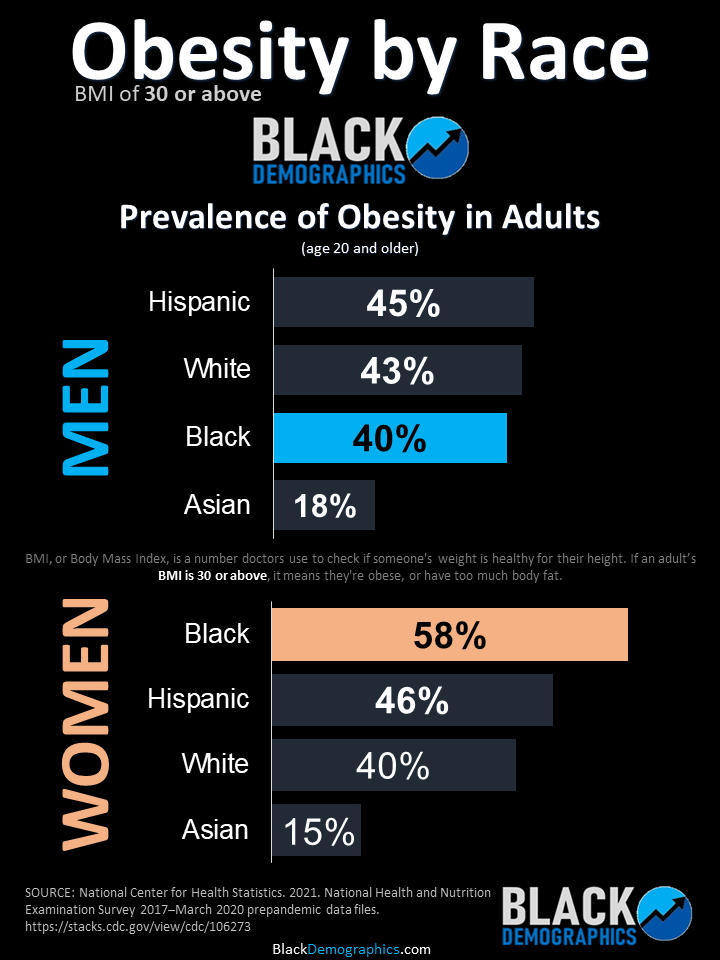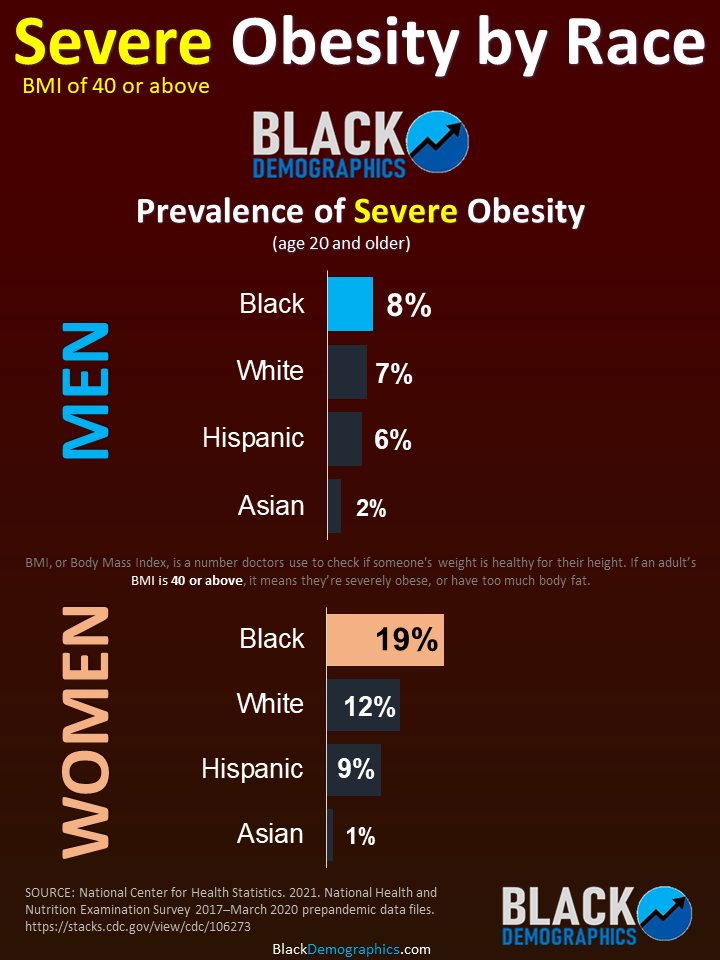
Navigating the Numbers: A Healthier Future for the Black Community
Introduction: At BlackDemographics.com, we believe in the power of data to shed light on challenges and opportunities within our community. A closer examination of recent health statistics regarding obesity rates among Black men and women reveal a detailed picture of where we stand and where we may need to focus for a healthier future.
What is BMI – Body Mass Index?
The CDC defines BMI as a person’s weight in kilograms divided by their square height in meters. A high BMI can indicate high body fatness.
- An adult with a BMI above 30 is considered obese
- An adult with a BMI above 40 is considered severely obese.
Key data from the National Health and Nutrition Examination Survey (2017–March 2020) provides us with these critical insights:
- Obesity Rates Among Black Adults: The survey indicates that 40% of Black men and 58% of Black women are statistically obese, which is defined as a Body Mass Index (BMI) of 30 or above.
- Comparative Rates Across Genders and Ethnicities: When compared with other ethnic groups, the obesity rate among Black men is higher than Asian men (18%) but lower than Hispanic (45%) and White men (43%). For Black women, the obesity rate (58%) is the highest among all groups surveyed, with Hispanic women at 46%, White women at 40%, and Asian women at 15%.
- The Gender Disparity: The difference in obesity rates between Black men and women (18 percentage points) highlights a significant gender disparity that warrants further exploration and targeted health interventions.

A Focused Look at Severe Obesity
Health Implications: Severe obesity is linked to a range of health issues. Understanding its prevalence helps to focus healthcare resources and prevention efforts in the communities most affected.
Severe Obesity is characterized by a Body Mass Index (BMI) exceeding 40, in contrast to a BMI of 30, which marks the threshold for obesity.
Broken down by race and gender:
- Severe Obesity in Black Adults: Black men and women exhibit the highest prevalence of severe obesity compared to their White, Hispanic, and Asian counterparts. Specifically, Black men have a severe obesity rate of 8%, slightly higher than White (7%), Hispanic (6%), and Asian (2%) men.
- A Closer Look at Black Women: The situation is even more pronounced among Black women, with a severe obesity rate of 19%, significantly exceeding the rates of White (12%), Hispanic (9%), and Asian (1%) women.
- Gender Disparities: Within the Black community, a notable gender disparity exists, with the severe obesity rate for Black women being more than double that of Black men, highlighting a critical area for targeted health interventions and research

Title: Understanding Child Obesity: A Data-Centric Look at Our Future Generation
Introduction: Childhood is a critical time for developing long-term health habits. Recent data on child obesity rates by race offers crucial insights that are imperative for guiding interventions and policies aimed at nurturing healthier future generations within the Black community.
Unpacking the Numbers: The infographic, drawing on data from the National Health and Nutrition Examination Survey (2017–March 2020), sheds light on the prevalence of obesity among children aged 19 and under, with a focus on racial demographics:
- Obesity Rates Among Boys:
- Hispanic boys lead with a 29% obesity rate.
- Black boys follow at 19%, closely paralleled by White boys at 18%.
- Asian boys have the lowest documented rate at 13%.
- Obesity Rates Among Girls:
- The rate for Black girls is at a concerning 31%, the highest among the groups.
- Hispanic girls have a 23% obesity rate.
- White girls are at 15%, and Asian girls at 5%, which is the lowest among the groups.
The Significance of These Findings: These figures highlight the importance of addressing child obesity with culturally sensitive and community-focused strategies:
- Health Implications for Children: Childhood obesity can lead to immediate health problems and increase the risk of obesity in adulthood. Addressing this issue early on is crucial for the overall health trajectory of these children.
- Socioeconomic and Cultural Influences: The data prompts us to look at the broader social and economic factors that influence childhood obesity, including education, income, access to healthy foods, and cultural dietary patterns.
- Community and Policy Interventions: With Black girls showing significantly higher obesity rates, there is a clear need for targeted interventions. This includes education for families, improved food policies in schools, and more accessible physical activities for children.
Conclusive Summary:
As we analyze the stark numbers reflecting obesity trends in the Black community, from our children to adults, a story unfolds that necessitates a proactive and comprehensive approach to health. The data shows that obesity in the Black community is an issue that develops from an early age, with 19% of Black boys and a worrying 31% of Black girls aged 19 and under being classified as obese. As we transition to adulthood, these numbers change, particularly for Black women, who exhibit the highest obesity rates.
This pattern signifies deep-rooted challenges tied to gender disparities, cultural dynamics, and socioeconomic factors, all of which demand early and culturally sensitive interventions tailored to the Black community’s unique needs. From promoting access to health services to advocating for healthier living environments, the call to action is clear.
BMI Disclaimer:
It is crucial to remember that BMI, while widely used, is a simplified tool that doesn’t capture the nuances of individual health profiles. It’s imperative to supplement BMI data with a holistic view of health that includes additional measures and considers the full context of an individual’s health status.
By acknowledging the limitations of BMI and emphasizing a multifaceted approach that includes community engagement, education, and policy advocacy, we can address the systemic issues contributing to these figures. Our commitment to the health of our community, especially our children, will help turn these numbers around and ensure a healthier, more vibrant future for all.
Call to Action: It is time to advocate for change and empowering our community with the knowledge and resources needed to live healthier lives. Together, we can redefine these statistics and build a legacy of health for generations to come.
Key Messages:
Conclusion:

